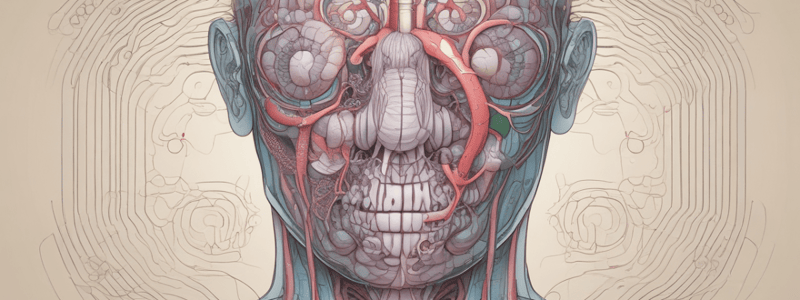Podcast
Questions and Answers
What is the primary function of the upper airway in the respiratory system?
What is the primary function of the upper airway in the respiratory system?
- To pump air into the lungs
- To filter out larger particles through impaction and smaller particles through sedimentation (correct)
- To exchange gases between the environment and the bloodstream
- To produce antioxidants to protect the lungs
What is the characteristic of the respiratory airways in the bronchial tree?
What is the characteristic of the respiratory airways in the bronchial tree?
- Thick walls of epithelium, smooth muscle, and cartilage
- Thin walls of mucosa, smooth muscle, and cartilage (correct)
- Thin walls of epithelium, smooth muscle, and cartilage
- Thick walls of mucosa, smooth muscle, and cartilage
What is the importance of gas laws in the process of respiration?
What is the importance of gas laws in the process of respiration?
- They are responsible for the production of ATP
- They control the flow of oxygen into the bloodstream
- They play a crucial role in the exchange of gases between the environment and the bloodstream (correct)
- They regulate the heartbeat
What is the function of the mucociliary escalator in the respiratory system?
What is the function of the mucociliary escalator in the respiratory system?
What is the component of the pump that ventilates the lungs?
What is the component of the pump that ventilates the lungs?
What is the function of the pulmonary circulation in the respiratory system?
What is the function of the pulmonary circulation in the respiratory system?
What is the approximate alveolar to arterial oxygen difference?
What is the approximate alveolar to arterial oxygen difference?
What is the shape of the oxyhaemoglobin dissociation curve?
What is the shape of the oxyhaemoglobin dissociation curve?
What factor influences the mechanics of the respiratory system?
What factor influences the mechanics of the respiratory system?
What is the primary function of the respiratory center in the brainstem?
What is the primary function of the respiratory center in the brainstem?
What is the result of a change in lung compliance?
What is the result of a change in lung compliance?
What is the relationship between the concentration of oxygen in the blood and the proportion of oxyhaemoglobin that is saturated with oxygen?
What is the relationship between the concentration of oxygen in the blood and the proportion of oxyhaemoglobin that is saturated with oxygen?
Flashcards are hidden until you start studying
Study Notes
Respiratory System
The respiratory system is a vital part of the human body, responsible for the exchange of gases between the environment and the bloodstream. It consists of two main parts: the lung, which is the gas-exchanging organ, and the pump that ventilates the lungs, which includes the chest wall, respiratory muscles, and central nervous system (CNS).
Upper Airway Structure
The upper airway, which includes the nose, pharynx, and larynx, serves to protect the respiratory system against environmental agents of lung disease. It does this by filtering out larger particles through impaction and smaller particles through sedimentation. The mucociliary escalator, along with macrophages, helps to remove particles that reach the alveoli, while the pulmonary circulation acts as a filter for the blood, particularly in removing blood clots.
Lower Airway Function
The conducting airways, such as the trachea and bronchi, have relatively thick walls of mucosa, smooth muscle, and cartilage. They form a typical respiratory surface, which is thin, moist, and vascular. The bronchial tree, which is disrupted in disease, has conducting airways with thick walls and respiratory airways with thin walls. The respiratory airways form a typical respiratory surface, which is thin, moist, and vascular.
Gas Laws in Respiration
Gas laws play a crucial role in the process of respiration. The partial pressures of oxygen (PaO2) and carbon dioxide (PaCO2) in alveoli and arterial blood are important factors in maintaining the balance of gas exchange. The alveolar to arterial oxygen difference (2Da-aO2) is approximately 0.67 kPa (5 mmHg), and when a normal subject hyperventilates, alveolar oxygen and carbon dioxide tension and arterial oxygen and carbon dioxide tension move down the slope in the respiratory exchange ratio of 0.8.
Oxyhaemoglobin Dissociation Curve
The oxyhaemoglobin dissociation curve is a graphical representation of the relationship between the concentration of oxygen in the blood and the proportion of oxyhaemoglobin that is saturated with oxygen. The curve is sigmoidal, meaning that small changes in oxygen concentration can lead to large changes in oxyhaemoglobin saturation. This curve is important for understanding how the body regulates oxygen delivery to tissues.
Mechanical Control of Ventilation
The mechanical control of ventilation involves the interaction of various factors, including respiratory mechanics, airway resistance, and V/Q mismatch. The mechanics of the respiratory system are influenced by the lung compliance, which is the relationship between lung volume and pressure. Changes in lung compliance can lead to altered breathing patterns, such as increased or decreased respiratory rate.
Neurological Control of Breathing
The neurological control of breathing is a complex process that involves the central nervous system, brainstem, and spinal cord. The respiratory center in the brainstem generates the drive to breathe, and this drive is influenced by various factors, including the oxygen and carbon dioxide levels in the blood, as well as the presence of respiratory drive-modifying stressors. The muscles of the chest and abdomen contract in a coordinated manner to produce the negative intrathoracic pressure required for inhalation and the positive intrathoracic pressure required for exhalation.
In summary, the respiratory system is a complex and vital system that is essential for maintaining life. It is made up of the lung, which is the gas-exchanging organ, and the pump that ventilates the lungs, which includes the chest wall, respiratory muscles, and central nervous system. Understanding the structure and function of the respiratory system is crucial for understanding how it maintains the balance of gas exchange in the body.
Studying That Suits You
Use AI to generate personalized quizzes and flashcards to suit your learning preferences.



